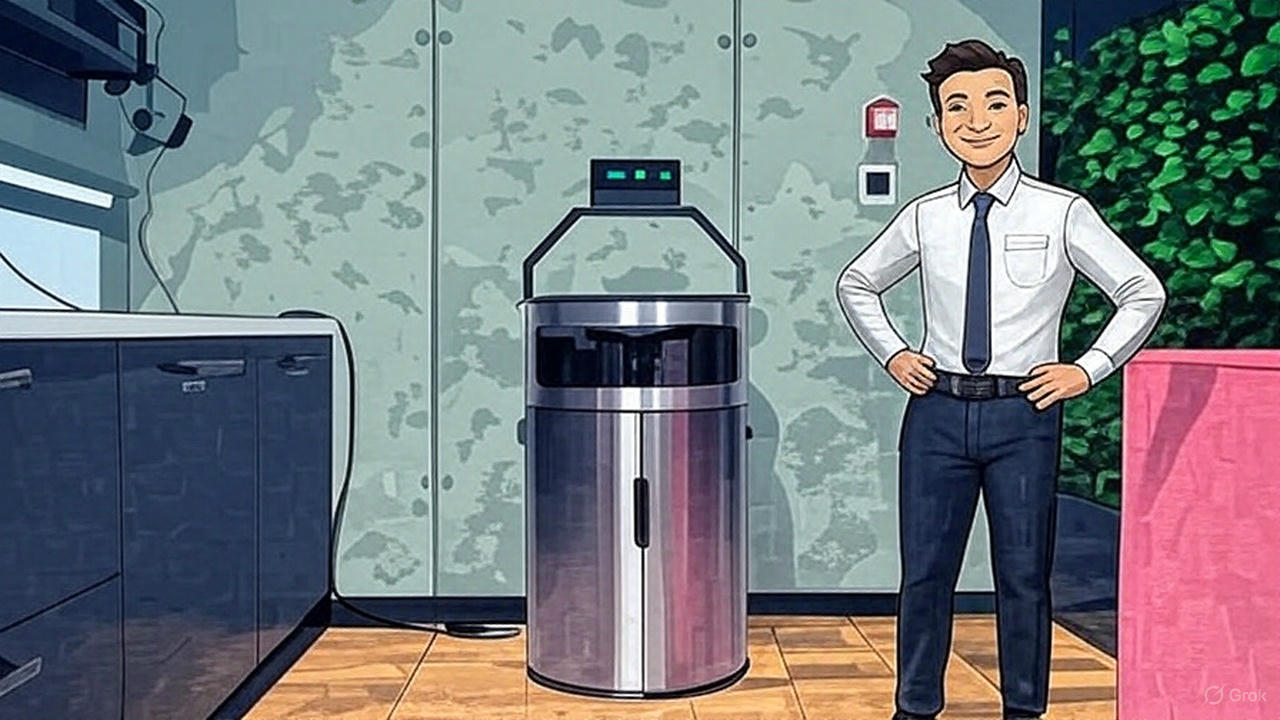
Kiril Gantchev
Introduction
Office recycling is often a mess. Busy employees toss paper, plastic, and coffee cups into the wrong bins, contaminating recyclables and sending them to landfills. This not only wastes resources but also increases CO2 emissions, harming the environment.
The Ameru Smart Bin solves this problem with AI-powered sorting that achieves 95% accuracy, making recycling effortless and effective. But does its environmental benefit outweigh its own carbon footprint? Absolutely! This post breaks down the numbers to show how the Ameru Smart Bin saves an estimated 85 tons of CO2 over its lifetime while keeping its footprint low.
What is the Ameru Smart Bin?
The Ameru Smart Bin is an AI-powered recycling solution designed for offices. Here’s what makes it stand out:
- AI Brain: Uses a Jetson Orin Nano Developer Kit to identify and sort waste with 95% accuracy.
- Interactive Display: A 10.1-inch touchscreen guides users with real-time feedback.
- High-Resolution Camera: An IMX 219 camera module scans waste for precise sorting.
- Durable Build: Made with 40 kg of stainless steel and 3D-printed PLA parts.
- Smart Sorting: Two servos and a bearing system sort waste into the correct compartments.
- Low Energy Use: Runs on just 15 watts, similar to a small LED bulb.
- Long Lifespan: Built to last 10 years, processing about 100 tons of waste.
This technology ensures that recyclable materials like paper, plastic, and metal are sorted correctly, reducing landfill waste.
Understanding Office Waste
To see the bin’s impact, let’s look at how much waste a typical office produces and how it’s managed today.
- Waste Output: Each office worker generates about 500 kg of waste per year. For a 50-person office, that’s 25 tons annually.
- Recyclable Waste: About 60% of office waste (paper, cardboard, plastics) is recyclable, equating to 15 tons per year in our example office.
- Current Recycling: Offices typically recycle only 50% of recyclable waste (7.5 tons in our example) due to sorting errors, with the rest often ending up in landfills.
This gap in recycling efficiency is where the Ameru Smart Bin makes a difference.
Manufacturing Emissions
Building the Ameru Smart Bin produces some CO2 emissions, but it’s a one-time cost for a decade of use. Below is a breakdown of the estimated emissions from its main components, organized by the bin’s three key parts: head unit, shell, and dumping mechanism.
| Component Group | Item | Quantity | Estimated CO2 (kg) |
|---|---|---|---|
| Head Unit | Jetson Orin Nano | 1 | 60 |
| 256GB NVMe SSD | 1 | 15 | |
| 10.1-inch Display | 1 | 25 | |
| IMX 219 Camera | 1 | 3 | |
| 3D-Printed PLA Parts (~2 kg) | 4 parts | 2.6 | |
| Subtotal | 105.6 | ||
| Shell | Stainless Steel Body (~40 kg) | 1 | 125 |
| 3D-Printed PLA Funnels (~3 kg) | 6 parts | 3.9 | |
| Steel Hinges (~2 kg) | 4 | 5 | |
| Subtotal | 133.9 | ||
| Dumping Mechanism | 20 kg Servos | 2 | 10 |
| 3D-Printed PLA Parts (~3 kg) | 6 parts | 3.9 | |
| 90mm Bearing (~1 kg) | 1 | 2.5 | |
| Subtotal | 16.4 | ||
| Total Manufacturing Emissions | 255.9 kg CO2 (≈ 0.26 tons) |
Table 1: Estimated Manufacturing Emissions for Ameru Smart Bin
Total Manufacturing Emissions: 105.6 + 133.9 + 16.4 = 255.9 kg CO2 ≈ 0.26 tons CO2
This is like the emissions from driving a car about 600 miles—small for a device that lasts 10 years.
CO2 Footprint and Savings
Let’s break down the bin’s total environmental impact and the CO2 savings it generates through better recycling.
Total Carbon Footprint
The bin’s carbon footprint comes from two sources:
- Manufacturing: 0.26 tons CO2 (from the table above).
- Operation:
- Power Use: 15 watts for 10 years = 1,314 kWh (15 watts × 24 hours × 365 days × 10 years ÷ 1,000).
- Emissions: 1,314 kWh × 0.5 kg CO2/kWh = 657 kg CO2 ≈ 0.66 tons CO2.
Total Footprint: 0.26 + 0.66 = 0.92 tons CO2.
CO2 Savings from Recycling
The Ameru Smart Bin’s high accuracy boosts recycling rates. Here’s how:
- Waste Processed: The bin handles 100 tons of waste over 10 years, or 10 tons per year.
- Recyclable Waste: 60% of office waste is recyclable, so that’s 6 tons per year (10 tons × 0.6).
- Sorted Correctly: With 95% accuracy, the bin sorts 5.7 tons per year (6 tons × 0.95).
- Over 10 Years: 5.7 tons × 10 = 57 tons of recyclables sorted correctly.
- CO2 Savings: Recycling saves about 1.5 tons of CO2 per ton of waste (average for paper, plastics, etc.). So, 57 tons × 1.5 = 85.5 tons CO2 saved.
Environmental Impact and Comparison
Now, let’s see how much CO2 the Ameru Smart Bin saves overall and how it compares to typical office recycling.
Net CO2 Savings
To find the bin’s overall environmental benefit, we subtract its carbon footprint from the CO2 savings:
- CO2 Savings: 85.5 tons (from recycling 57 tons of waste).
- Carbon Footprint: 0.92 tons (manufacturing + operation).
- Net Savings: 85.5 - 0.92 = 84.58 tons CO2 saved.
This means the bin saves over 90 times its own footprint (85.5 ÷ 0.92 ≈ 92.9), making it a powerful tool for reducing emissions.
Comparison to Typical Recycling
How does the Smart Bin stack up against standard office recycling? Let’s compare the two scenarios over 10 years for the 6 tons of recyclable waste the bin processes annually.
| Scenario | Recycling Rate | Recyclables per Year (tons) | Total Recyclables (tons, 10 years) | CO2 Savings (tons, 10 years) |
|---|---|---|---|---|
| Without Smart Bin (Baseline) | 50% | 3 (6 tons × 0.5) | 30 (3 × 10) | 45 (30 × 1.5) |
| With Ameru Smart Bin | 95% | 5.7 (6 tons × 0.95) | 57 (5.7 × 10) | 85.5 (57 × 1.5) |
| Additional Benefit | +45% | +2.7 tons | +27 tons | +40.5 tons |
Table 2: Comparison of Recycling and CO2 Savings (10 Years)
Key Insights:
- Extra Recycling: The Smart Bin recycles 27 tons more than the baseline (57 - 30 tons).
- Extra CO2 Savings: This translates to 40.5 tons more CO2 saved (27 × 1.5).
- Total Impact: The Smart Bin’s 85.5 tons of CO2 savings far outweigh its 0.92-ton footprint, delivering a net benefit of 84.58 tons CO2.
Making Offices Greener

The Ameru Smart Bin makes sustainable waste management simple. Here’s how offices can use it:
- Strategic Placement: Place bins in high-traffic areas like break rooms or near copiers.
- Employee Engagement: Use the touchscreen to guide and educate staff on recycling.
- Track Progress: Review monthly analytics reports to monitor recycling rates and set goals.
- Celebrate Impact: Share CO2 savings with your team to boost morale and commitment.
By adopting the Ameru Smart Bin, offices can reduce landfill waste and achieve significant CO2 savings—84.58 tons over 10 years, including 40.5 tons more than current practices.
Conclusion
The Ameru Smart Bin is a sustainability superstar. Its minimal carbon footprint (0.92 tons CO2) is dwarfed by the 85.5 tons of CO2 it saves through better recycling. That’s a net savings of 84.58 tons, making it a must-have for eco-conscious offices. Ready to transform your office’s waste management? Contact us to learn more!
